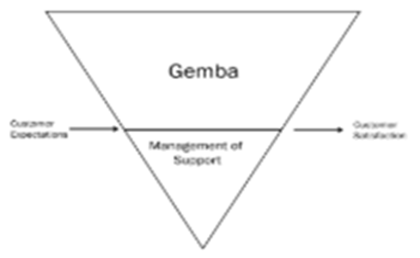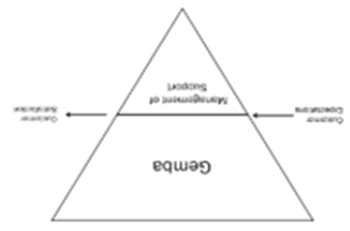गेम्बा वॉक: प्रभावशीलता के लिए अंतिम गाइड
Gemba means "at floor", referring to the place where real work takes place. The 'real work' in this case is the actual production process. In Japanese language, production work is often described using the mnemonics 3K, which refers to:
1) Kiken - “dangerous”
2) Kitanai - “dirty”
3) Kitsui - “difficult”
Gemba walk is a Japanese concept which focuses on adding customer-oriented value at the floor. These values need to be incorporated in the product or service to enhance customer satisfaction.
In this article, you will learn about the
■ focus of gemba,
■ gemba relationship with the structure of an organisation,
■ attribute of an effective gemba walk,
■ impact of a gemba culture and the
■ 6 fundamental seps for an effective gemba or process walk.
Gemba Defined
Gemba simply refers to the place where real work happens. Due to the actual happenings on the shop floor, managers often do not like to go there. Today, the leaders and presidents of reputable Japanese companies have sufficient working experience in Gemba. Their insight on the shop floor enables them provide assistance where necessary.
 Click Here to Join the Over 2,600 Students Taking our Highly Rated Courses on Quality Assurance/Quality Control, Lean Six Sigma, Lean Manufacturing, Six Sigma, ISO 9001, ISO 14001, ISO 22000, ISO 45001, FSSC 22000, Product Development etc. on UDEMY.
Click Here to Join the Over 2,600 Students Taking our Highly Rated Courses on Quality Assurance/Quality Control, Lean Six Sigma, Lean Manufacturing, Six Sigma, ISO 9001, ISO 14001, ISO 22000, ISO 45001, FSSC 22000, Product Development etc. on UDEMY.
Focus of Gemba
Gemba is not only focused on production but also on cost, delivery and quality. However, the overall focus and innate intention for conducting Gemba is improvement on the floor. Gemba helps company thrive and prosper. The merger of Gemba and Kaizen is also known as Gemba Kaizen.
The different management layers comprise of top management, engineering persons, middle management and supervisors. They all exist to offer the required help and support to the work-site for operations, Gemba should be the ground of all improvement initiatives and the origin of all information adopted by these people.
It is vital for these levels of management to keep close contact with the realities of the shop floor in order to fix all problems that arise there. Management assistance offers should begin from the particular needs of the worksite and that is where the role of Gemba comes in. When management does not acknowledge Gemba, it tends to reflect negatively on the actual improvements on the shop floor.
 Click Here to Join the Over 2,600 Students Taking our Highly Rated Courses on Quality Assurance/Quality Control, Lean Six Sigma, Lean Manufacturing, Six Sigma, ISO 9001, ISO 14001, ISO 22000, ISO 45001, FSSC 22000, Product Development etc. on UDEMY.
Click Here to Join the Over 2,600 Students Taking our Highly Rated Courses on Quality Assurance/Quality Control, Lean Six Sigma, Lean Manufacturing, Six Sigma, ISO 9001, ISO 14001, ISO 22000, ISO 45001, FSSC 22000, Product Development etc. on UDEMY.
Management Role
One of core roles of management is to help the Gemba do a better job by reducing constraints as much as possible. In some Western companies where the influence of strong unions practically controls the Gemba, management avoids involvement in Gemba affairs, and in places where the union does not exercise a firm grip, Gemba work is left to veteran supervisors who are allowed by management to run the show as they please. In these two cases, management has lost control of the workplace.
Gemba and Management Structure
Both inverted and normal concepts are equally valid in terms of Gemba and Management interaction. Both Gemba and management enjoy equally important status. Gemba contributes to offering products and/or services that satisfies their customers. They provide support by focusing on strategy and deploying the policy to attain that goal in the Gemba.
Inverted Triangle
The inverted triangle model shows Gemba residing on top of the management structure. In this, Gemba is at the top meaning that managers can examine where they should get information from and discover from workers at the floor with the goal of offering relevant assistance.

Normal Triangle
This normal triangle model shows Gemba residing at the bottom of the management structure. In this, management stays on top of the organization. They are expected to take the initiative in developing policies, objectives, and priorities and in providing resources e.g. money and manpower. Here, they must work through leadership and identify the level of Kaizen most promptly required. This is also known as policy deployment.

 Click Here to Join the Over 2,600 Students Taking our Highly Rated Courses on Quality Assurance/Quality Control, Lean Six Sigma, Lean Manufacturing, Six Sigma, ISO 9001, ISO 14001, ISO 22000, ISO 45001, FSSC 22000, Product Development etc. on UDEMY.
Click Here to Join the Over 2,600 Students Taking our Highly Rated Courses on Quality Assurance/Quality Control, Lean Six Sigma, Lean Manufacturing, Six Sigma, ISO 9001, ISO 14001, ISO 22000, ISO 45001, FSSC 22000, Product Development etc. on UDEMY.
Direct & Indirect Earners
The idea of direct versus indirect earners throws more light on the importance of Gemba. Gemba walk is an improvement on the floor for direct earners which requires the strong support of indirect earners.
Direct Earners
These are the people who are involved in the manufacturing of the product and/or the delivery of services. These are production personnel on the shop floor. If they stop work for one minute, the business prospect of making more money will be lost by one minute. Roles that directly support direct earners include maintenance, logistics, procurement personnel etc.
Indirect Earners
The indirect earners are the people who are not directly involved in making products or providing services; they have no direct role in daily product making or service offering. They represent the people at the top layers of organizational hierarchy; examples include CEOs, Directors, Managers, President, and other supporting areas including Quality, Finance, and Human Resource etc.
Despite how hard these people work in their respective areas, they do not directly earn money instead they are in the company to support those who are directly earning money for the company by making products, delivering services etc.
 Click Here to Join the Over 2,600 Students Taking our Highly Rated Courses on Quality Assurance/Quality Control, Lean Six Sigma, Lean Manufacturing, Six Sigma, ISO 9001, ISO 14001, ISO 22000, ISO 45001, FSSC 22000, Product Development etc. on UDEMY.
Click Here to Join the Over 2,600 Students Taking our Highly Rated Courses on Quality Assurance/Quality Control, Lean Six Sigma, Lean Manufacturing, Six Sigma, ISO 9001, ISO 14001, ISO 22000, ISO 45001, FSSC 22000, Product Development etc. on UDEMY.
Steps for Conducting a Good Gemba Walk
As a manager before walking on the shop floor, it is very important you make a plan and follow the right steps. The plan should consist of the following:
Choose a Theme
It is a requirement for Gemba, to choose a theme for your Gemba walk. Examples can include safety, productivity and others.
Clarify the Purpose of Gemba
The purpose of the Gemba walk should be clear with all the team. They should be aware of the purpose of gemba, serving as a technique for continuous improvement for the benefit of everyone in the organization. The advantage of this is that it creates solid ground for effective collaboration.
Evaluate Process, not People
Gemba is primarily focused on process, not on people with the goal of observing, comprehending and enhancing the process for better performance. Questioning people’s abilities will result in resistance.
Visit Value Stream
A best practice to adopt is following the value-chain. This gives the best prospects to identify regions with a huge potential of waste activities.
Capture Observations
Making suggestions during the walk is not necessary. All you need to do at this stage is capturing all that attracts your attention using mobile devices is necessary. Some situations may leave you with no choice but to propose a solution right away, but this wouldn't be the best. Analysis of the current state should be kept for later review when you are more relaxed to provide accurate and precise analysis by employing effective problem-solving tools. It would be better than an instant feeling.
Fresh Viewpoint
Having a colleague from another department for Gemba is usually an advantage. Ideally a person who has entirely different working background is preferred. Experience shows that individuals with less awareness of the daily processes normally have a fresh eye to see things differently and often ask different questions.
Follow up
Gemba walk may not always yield substantial observation, but you should still share your experience with with the team for analysis. This should be should be done to ensure objectivity. Ensure not to blame them, but be reasonable about areas of improvement. If you are making actions after the walk, take the team in confidence about the future changes and why they are significant.
 Click Here to Join the Over 2,600 Students Taking our Highly Rated Courses on Quality Assurance/Quality Control, Lean Six Sigma, Lean Manufacturing, Six Sigma, ISO 9001, ISO 14001, ISO 22000, ISO 45001, FSSC 22000, Product Development etc. on UDEMY.
Click Here to Join the Over 2,600 Students Taking our Highly Rated Courses on Quality Assurance/Quality Control, Lean Six Sigma, Lean Manufacturing, Six Sigma, ISO 9001, ISO 14001, ISO 22000, ISO 45001, FSSC 22000, Product Development etc. on UDEMY.
Attributes of a Successful Gemba
A successful gemba has the following attribute:
- Acknowledges responsibility for achieving quality, cost, and delivery (QCD).
- Offer the objectives for the Gemba to attain but should be responsible for the outcomes as well.
- Assists the Gemba team in attaining the target.
- Clearly identified by the workers on the floor.
- Wins strong support of the management to minimize resistance at the floor.
- Successful Gemba Kaizen takes the inputs those thinking about all types of problems and solutions on the production line.
- Worker and management-led continual improvement become achievable.
- Focuses on common sense and economical methods instead of costly and method-oriented ways.
- Workers appreciate Kaizen and are indeed inspired by this methodology.
- Enables improvement of awareness of Kaizen and work efficiency simultaneously.
- Assists employees on the floor to think about improvement during work.
- Enables all in the organization (upper management, middle management and others) to contribute to small improvements.
 Click Here to Join the Over 2,600 Students Taking our Highly Rated Courses on Quality Assurance/Quality Control, Lean Six Sigma, Lean Manufacturing, Six Sigma, ISO 9001, ISO 14001, ISO 22000, ISO 45001, FSSC 22000, Product Development etc. on UDEMY.
Click Here to Join the Over 2,600 Students Taking our Highly Rated Courses on Quality Assurance/Quality Control, Lean Six Sigma, Lean Manufacturing, Six Sigma, ISO 9001, ISO 14001, ISO 22000, ISO 45001, FSSC 22000, Product Development etc. on UDEMY.
About the Author
Adebayo is a thought leader in continuous process improvement and manufacturing excellence. He is a Certified Six Sigma Master Black Belt (CSSMBB), Digital Manufacturing Professional and ISO Management Systems Lead Auditor (ISO 9001, 45001 & ISO 22000) with strong experience leading various continuous improvement initiative in top manufacturing organizations.
You can reach him here.
